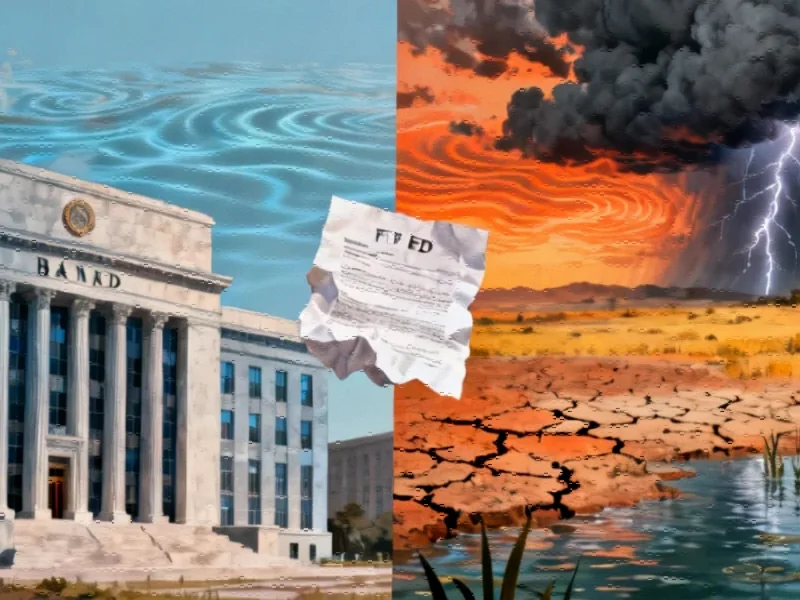Policy Shift in Banking Regulation
In a significant reversal of financial policy, federal banking regulators have officially rescinded requirements for major financial institutions to incorporate climate risk considerations into their long-term strategic planning. The Federal Reserve and Federal Deposit Insurance Corporation announced the change Thursday, stating that existing risk management frameworks already adequately address all material financial risks facing banking institutions.
The decision represents the latest in a series of regulatory rollbacks targeting climate-focused policies implemented during the previous administration. Federal Reserve Board staff characterized the now-rescinded mandate as “distracting” and “not necessary,” while Republican lawmakers had long criticized the policy as regulatory overreach.
Divergent Perspectives Within Regulatory Bodies
The move has exposed clear divisions among Federal Reserve governors, with Trump-appointed officials celebrating the change while Biden nominees expressed concern about potential economic consequences. Fed Vice Chair for Supervision Michelle W. Bowman defended the decision, arguing that requiring banks to consider climate risks beyond their typical planning horizon invited “highly speculative” analysis of limited utility.
Meanwhile, Biden-appointed board member Michael S. Barr warned that revoking the principles “defies logic and sound risk-management practices” at a time when climate-related financial risks are increasing. He emphasized that weaknesses in how institutions identify, measure, and monitor climate risks could ultimately affect their safety and soundness.
Industry Response and Existing Practices
Banking industry representatives welcomed the regulatory shift, noting that institutions were already addressing climate concerns within their established risk management frameworks. Austin Anton, spokesman for the Bank Policy Institute, stated that “banks already manage climate risk as part of their existing risk management frameworks” and characterized the rescinded guidance as redundant rather than additive.
The policy change comes amid broader industry developments where economic growth continues to outpace environmental efficiency gains. This disconnect highlights the ongoing challenge of balancing economic priorities with environmental considerations across multiple sectors.
Broader Regulatory Context
This banking policy reversal follows similar retreats from climate-focused regulation across federal agencies. The Securities and Exchange Commission previously scaled back ambitious rules requiring public companies to disclose climate-related risks to investors, while the Office of the Comptroller of the Currency abandoned the climate risk guidance in March.
The regulatory pullback occurs as researchers warn that continued warming could cost the global economy more than $38 trillion annually in coming decades. Despite these projections, the current administration has prioritized boosting fossil fuel industries and domestic energy production, reflecting a significant shift in federal regulatory approach to climate-related financial risk.
Practical Implications for Banking Operations
While the policy did not specify exactly how banks should factor climate risks into their planning, it required them to do so across various business aspects. Laurie Schoeman, former senior adviser on climate risk and resilience in the Biden administration, noted that “it was helpful to have the government saying, ‘We didn’t care how you were doing it, but you had to do it.'”
The banking sector continues to navigate market trends that demand adaptability and strategic repositioning, much like other industries facing evolving regulatory and economic landscapes. This flexibility remains crucial as institutions respond to changing policy environments.
Looking Forward: Risk Management in a Changing Climate
Despite the regulatory reversal, many large banks are expected to continue considering weather-related risks in their planning processes, recognizing the material financial implications of extreme weather events, rising sea levels, and other climate-related factors. The fundamental challenge of assessing long-term risks in a changing climate remains, regardless of regulatory requirements.
As the financial sector adapts to this new regulatory reality, parallel related innovations in other industries demonstrate how technological advancements continue to transform risk management approaches across sectors. The intersection of technology, regulation, and risk assessment will likely remain a dynamic area of focus for financial institutions navigating an increasingly complex operational environment.
The policy shift highlights ongoing tensions between regulatory approaches to climate risk and raises questions about how financial institutions will voluntarily address what many scientists and economists consider one of the most significant long-term threats to global economic stability.
This article aggregates information from publicly available sources. All trademarks and copyrights belong to their respective owners.
Note: Featured image is for illustrative purposes only and does not represent any specific product, service, or entity mentioned in this article.



